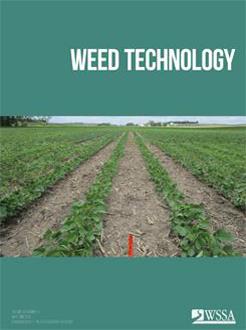Transgenic crops are being developed with herbicide resistance traits to expand innovative weed management solutions for crop producers. Soybean with traits that confer resistance to the hydroxyphenylpyruvate dioxygenase herbicide isoxaflutole is under development and will provide a novel herbicide mode of action for weed management in soybean. Ten field experiments were conducted over 2 years (2017 and 2018) on five soil textures with isoxaflutole-resistant soybean to evaluate annual weed control using one- and two-pass herbicide programs. The one-pass weed control programs included isoxaflutole plus metribuzin, applied PRE, at a low rate (52.5 + 210 g ai ha-1), medium rate (79 + 316 g ai ha-1), and high rate (105 + 420 g ai ha-1); and glyphosate applied early postemergence (EPOST) or late postemergence (LPOST). The two-pass weed control programs included isoxaflutole plus metribuzin, applied PRE, followed by glyphosate applied LPOST, and glyphosate applied EPOST followed by LPOST. At 4 weeks after the LPOST application, control of common lambsquarters, pigweed species, common ragweed, and velvetleaf was variable at 25% to 69%, 49% to 86%, and 71% to 95% at the low, medium, and high rates of isoxaflutole plus metribuzin, respectively. Isoxaflutole plus metribuzin at the low, medium, and high rates controlled grass species evaluated (i.e., barnyardgrass, foxtail, crabgrass, and witchgrass) 85% to 97%, 75% to 99%, and 86% to 100%, respectively. All two-pass weed management programs provided 98% to 100% control of all species. Weed control improved as the rate of isoxaflutole plus metribuzin increased. Two-pass programs provided excellent, full-season annual grass and broadleaf weed control in isoxaflutole-resistant soybean.
Nomenclature Glyphosate; isoxaflutole; metribuzin; barnyardgrass, Echinochloa crus-galli (L.) P. Beav.; common lambsquarters, Chenopodium album L.; common ragweed, Ambrosia artemisiifolia L.; giant foxtail, Setaria faberi Herrm.; green foxtail, Setaria viridis L. P. Beauv.; horseweed, Erigeron canadensis L. Cronq.; Powell amaranth, Amaranthus powellii S. Watson; redroot pigweed, Amaranthus retroflexus L.; soybean, Glycine max (L.) Merr.; velvetleaf, Abutilon theophrasti Medik.; waterhemp, Amaranthus tuberculatus Moq. J. D. Sauer






